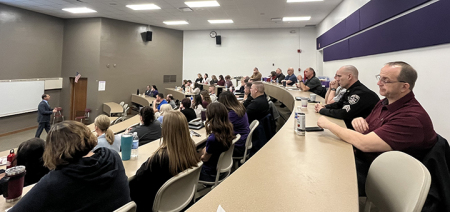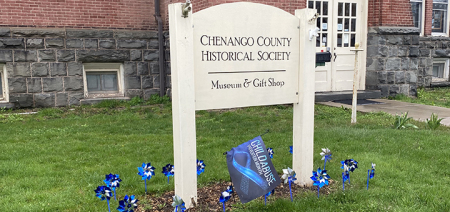Project Chenango: Educating Chenango
Published:
November 5th, 2015

By Melissa Stagnaro
Special to The Evening Sun
stagnaro.melissa@gmail.com
CHENANGO – “We were Sus-East champions,” Julie Gates said, recalling how as a high school freshman, she tended goal for Oxford’s varsity field hockey team.
Gates, a 1981 graduate of Oxford, talks about those long ago days with pride and acknowledges the impact the program and coach Sue Franco had on her as a teen.
“She was my mentor,” she said.
That field hockey program, once a point of pride for the district, no longer exists. It is one of a string of athletic and extracurricular cuts Oxford and other districts have made in past years as a result of both financial pressures and declining enrollment.
This year Oxford didn’t have enough kids to field a boys’ soccer team. In May, the district will graduate fewer than 60 students. In the mid-90’s, when its enrollment peaked, it had more than 100 graduates.
Gates, whose eldest son graduated last year and younger son is in high school, serves on the district’s school board. She said she’s been disappointed to see programs cut due to participation, but is encouraged by other offerings that have been added as the school changes and evolves to meet the needs of its students.
The biggest change, and one that has been a focus of media coverage and community debate, is implementation of the Common Core curriculum.
Social media abounds with horror stories about the Common Core - first grade math homework taking an hour and fifth grade math too complicated for a parent to help. Some of these stories have gone completely viral, like the tale of a frustrated parent who wrote a check to the school written in ‘Common Core math’. Another, about a third grade math quiz where a student was marked off for solving a question incorrectly despite having the right answer, sparked outrage in the national media.
Education expert Gray Stevens, who started his administrative career at Oxford, weighed in on what has been a controversial topic now for more than 4 years.
“The term Common Core has come to represent everything negative surrounding the idea of too much testing and teachers being evaluated on their student test results,” he said.
In reality, he explained, the intention behind Common Core is the idea of a common curriculum across the country so that a student in New York receives the same education as one in any other state. This fact has been lost, however, in how it was implemented by New York State.
Because of the speed at which it was rolled out, he said schools and communities weren’t given time to prepare for the major changes the new learning standards represented. Matters were complicated further by the state’s decision to almost immediately begin evaluating teachers based on the results of student exams on that un-vetted curriculum.
This was a “recipe for disaster,” according to Stevens, as it failed to take into consideration that institutions such as schools require time to make such changes.
Like big ships, he said, “it takes them a long time, good preparation and a wide radius to turn.”
“I am encouraged by what I have heard from our new Commissioner of Education,” Stevens said. “I expect to begin seeing practical changes to some of the requirements that were not well thought through.”
At the Norwich City School District, Superintendent Gerard O’Sullivan admits the implementation of the Common Core has been the district’s biggest challenge, but says they are better off than some of their peers.
“We’ve not seen the issues and problems other districts have seen,” O’Sullivan said.
The superintendent chalks this up to the district’s faculty and staff.
“The Common Core Learning Standards are pushing our staff and students to new levels of skill and subject mastery,” he said. “What is most exciting is seeing staff and students responding and watching a daily progression to higher levels of mastery.”
O’Sullivan said he’s proud of the way the district’s teachers and staff are embracing the challenges and working collaboratively – motivating and helping one another achieve success.
“Across the district, staff are all working in a unified and cohesive fashion which is making it better and easier for students to find success,” he said. “We’re finding common ground and students are benefiting.”
While O’Sullivan stressed that schools have always had learning standards, the Common Core does represent a structural shift from the way particularly math and ELA were taught before. Those shifts, he explained, are designed to give students a more depth understanding of concepts. In math, the goal is to better prepare students for higher mathematics and how they are applied to engineering and technology.
In order to help parents acclimate to the new learning standards, the district has reframed its Open Houses into Curriculum Nights. And O’Sullivan stressed that teachers are always willing to sit down with parents who may have questions.
According to the superintendent, it’s getting easier now that the new learning standards are now entering their fourth years. That means parents are starting to see the repetition, and how the concepts build in each other year after year. Students are more prepared as they move from one grade to the next.
“The familiarity is building more and more each year,” he said.
O’Sullivan agrees with Stevens that the problem was in how it was implemented at the state level.
“It was a mistake rolling out the common core and attaching it to other things,” he said, referring to the mandated teacher evaluations.
But Norwich and other districts didn’t have a choice but to comply as their funding depended on it. It didn’t help that the roll-out came at a time when the cash-strapped state was pulling back funding from districts across New York. O’Sullivan said Norwich is only now starting to see a reverse in that trend.
“We’re starting to see some money restored to previous levels,” he said. He cautions that the district isn’t out of the woods yet.
“We’ve lost millions of dollars over the last several years.”
At Unadilla Valley, Superintendent Robert Mackey also lists financial strain as one of the biggest challenges faced by the district. It’s something he says is complicated by the ‘steady stream’ of mandates handed down from both the federal and state levels.
“We are trying to keep these new mandates from negatively affecting students and staff as they work on navigating the era of scarce resources while remaining progressive, keeping our forward lean out of the blocks and providing great programs for our students,” he said.
Mackey cites a number of positive trends in the district, which is focused on achieving a 100 percent graduation rate.
“Our staff is focused on the right work and students are doing better than ever academically,” he said. “[We are working] to implement a collaborative culture where teachers meet often during the week to look at student learning and make adjustments to instruction in order to guarantee learning for all students.”
It’s important to note Mackey’s use of the word “learning.” It’s reflective of the shift UV’s staff has made to focus on learning, rather than teaching.
“This is ‘non-traditional’ so to speak, and given the new teacher and principal evaluation mandates, as well as the political rhetoric of our governor, this is a very difficult shift to make,” the UV superintendent explained.
That said, UV is committed to making the change.
“Our school improvement team recognizes the importance of this and has made it their priority to imbed the focus on learning and collaboration into the normal day-to-day procedures of the staff,” he said.
According to Mackey, school spirit is on the rise and is reflected in students’ desire for academic success and participation in extracurricular activities.
“It is exciting to hear their spirit at school, games and other events,” he said.
That spirit also extends to the community.
“The students and staff are working to build a better future for the students and the greater Unadilla Valley region,” Mackey said.
“Working together with our residents and businesses we can, as our Alma Mater says, ‘honor our history and future.”
BOCES
Stevens, who since his retirement from Oxford has helped a number of districts through transitions, is now working with DCMO BOCES to help with their transition following the departure of District Superintendent Bill Tammaro.
Broome-Tioga BOCES District Superintendent Allen Buyuck is acting as interim district superintendent and Stevens as chief operating officer.
“My job is to make sure services operate smoothly and component school districts are provided with the help and support they need,” said Stevens, explaining his role is a temporary one.
Just how temporary depends on the results of a study commissioned by the state to determine the future of the BOCES district. The Rockefeller Institute, which conducted the study, filed their report on Monday.
“It’s now up to the Commissioner of Education and the State Education Department to decide, based on the report, if the DCMO BOCES will remain in its present configuration and seek a new District Superintendent or whether it will take on another configuration,” Stevens said.
The search for a new district superintendent can’t begin until the state makes that determination. Playing the waiting game has been challenging, Stevens admitted, but he credits the district’s employees with their dedication to adding and improving the services they provide despite the uncertainty.
“The staff at BOCES is amazingly resilient and committed to providing the best possible services and support to the local districts,” he said. “I am very proud to be working with this group. They continue to earn my respect.”
One of the things Stevens said he values most from his days as a school superintendent was the role DCMO BOCES plays in bringing school leaders together to find local solutions to pressing problems and issues.
“In a time of significant and seemingly constant change in education, it is vital that school leaders have the regular opportunity to meet and have facilitated discussion centered around problem solving,” he said. “This BOCES has been a leader in providing the arena and leadership for this.”
Gates appreciates BOCES for another reason.
“BOCES offers so much for students,” she said. Her oldest son, currently a student at Morrisville State College, went through the automotive program. Her youngest is enrolled in the criminal justice program.
She considers it important that students are made aware of all the options in front of them when they graduate high school.
Both Mackey and O’Sullivan agree. Their districts have both made helping students earn college credits while still in high school a priority to better prepare college-bound students for their future.
COLLEGE READINESS
“Students have nearly 100 college credit hours available to them at a nominal cost,” said Mackey. “A two-year college degree, earned nearly completely on our campus, is within reach for many of our students.”
Norwich works closely with Morrisville State College.
“Our dual enrollment college program continues to grow and expand and more students are…earning college credit and saving thousands of dollars in tuition,” O’Sullivan said.
Approximately 120 students are currently enrolled in one or more of the 14 courses being offered; all taught by Norwich’s own teachers, who have gone through an application process with the college and had their lesson plans approved.
O’Sullivan is particularly proud of an offshoot of the program which gives students the opportunity to attend one of 6 classes at Morrisville’s Norwich campus. It offers the best of both worlds – a safe environment, but also a taste of the college experience and college level responsibility, he said.
Morrisville’s Norwich campus has been serving the community for close to 50 years, according to Executive Director Jason Zbock.
Their biggest challenge, he said, is getting the word out about the quality and affordability of their course offerings.
And right now there’s a great deal he’d like to spread the word about. Including facilities and program upgrades and new offerings designed to meet the campus’ goal of providing career-focused experiential learning.
“Our co-created vision with the community is to offer increased applied learning experiences to students working with businesses and community partners,” Zbock said. “These experiences are in and out of the classroom in the form of workshops, internships and field experience.”
New initiatives include courses hosted by area employers, STEM educator training workshops and non-credit training in Microsoft Excel for beginning and intermediate level learners.
Community is an important focus, and plays a large role in the campus’ strategic plan moving forward.
“The Norwich Campus continues to thrive by partnering with the community to develop academic courses, programs and training programs to serve the needs of the current and future workforce,” Zbock said.
Comments








